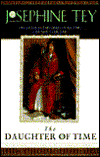
Scotland Yard Inspector Alan Grant lies in a hospital bed with a broken leg. To alleviate his boredom, a friend brings him a pile of pictures: photographs, prints, engravings, and clippings. Among the more engrossing images is the portrait of King Richard III. Studying the benign face, he asks himself how such a sensitive-appearing soul could have been the infamous murderer of his own nephews. With the help of the British Museum and an American scholar, Grant reconsiders 500-year-old evidence pertaining to one of the most intriguing murder mysteries of all time. Josephine Tey's answer to who really killed the two princes in the Tower of London has provoked controversy ever since its publication in 1951.
The Daughter of Time is actually the fifth book in a series of six mysteries that feature Inspector Grant. Normally the fact that I was reading a book from a series out of order would really freak me out, however, it didn't this time, mainly because I didn't find out until after I finished it!
With the first book in the series being published in 1929 and this one published in 1951, it is actually a pretty old book, and yet for the most part it does not feel dated at all. There are the occasional things which are, for example the Inspector smoking in his hospital bed, a little bit of the language (calling gangsters wideboys)...oh, and the fact that there was no internet to assist with the research, but overall the story is so well written that it holds up for today's reader without too many problems.
The story is that Inspector Grant is stuck in hospital after falling through a trap door with a broken leg (presumably in the book before this), and so he is in hospital laying flat on his back for weeks (Okay...so maybe it is a little dated. My sister recently broke her kneecap and was out of hospital in two days). Nearly driven round the twist with boredom, one of his friends goes and gets some portraits of historical figures that are connected to unsolved mysteries of the past to see whether that kind of mental exercise will help cheer him up. After discarding some pretty famous names like Perkin Warbeck and Lucrezia Borgia, Grant spies a portrait of Richard III. Priding himself as a man who is able to be a good judge of character based solely on a face, Grant finds himself wondering how a man who looks like Richard III has been portrayed through the years as one of the most evil kings of England ever.
So Grant, with the able assistance of a young American researcher by the name of Brent Carradine, sets out to track down contemporary accounts of Richard III to try and found out what the man was really liked. Having discovered that most of the famous accounts were either hearsay or written by Richard's enemies, Grant decides to use the skills that he has gained at Scotland Yard to in effect investigate Richard and see whether he could possibly be guilty of the things that he has been accused of doing over the years, including murdering his own two nephews in order to gain the crown for himself.
He starts with a series of questions. For example, where was Richard when he found out that his older brother King Edward IV had died? What did he do when he heard? Were his actions consistent with those of a man who had gaining the throne for himself as his foremost concern? Using the same approach for many of the other key figures, by following through some of the key events from history and investigating logically, Grant comes up with some quite interesting theories as to what really happened all those years ago.
I have to admit that I am quite partial to a story about Richard III. This interest started when I read Sunne in Splendour by Sharon Penman, and has continued through The Seventh Son by Reay Tannahill, and most recently, A Rose for the Crown. For some reason I do always end up reading novels that are very pro Richard, and this one is no exception, although this one does come up with a different answer to that age old question - if Richard didn't kill the princes in the tower...then who did!
In terms of the style of the novel, it is an interesting mix - more like a case study than your traditional historical fiction novel. Whilst I would guess that the book would qualify as a historical mystery, it is interesting to note that the author didn't take us back in time, and feel the need to share the smells, dresses and rituals of the time, but rather gives us an analytical look back at a particular character, and a particular series of events that were pretty crucial to English history. It is an unusual way of writing the book, but it works.
One interesting thing that I found, was that Miss Tey put a reference to the Inspector going to watch one of the plays that she had written under her other pen name of Gordon Taviot. Normally when I read that kind of thing, for example when an author writes themselves into the story, I find it kind of jarring. It did amuse me to think that kind of thing was happening all those years ago as well. There is nothing new under the sun...apparently!!
A very entertaining read of a book that is probably as close to a historical fiction classic that you can get, and well worth trying to get hold of! I have every intention of reading more from this author.
Rating 4.5/5
Other Blogger's Thoughts:
A Girl Walks Into a Bookstore







I read this book over 20 years ago; I found it at the library, loved it, and wanted to read more. Many of her books were out of print at the time, and I only found a few. Thanks for the reminder.
ReplyDeleteI also have, over the years, enjoyed several different versions of the Richard III story in historical fiction. From Shakespere to Tey and beyond, Richard's interpretations vary drastically.
Now I wish I had bought this book, it looks interesting
ReplyDeleteI really enjoyed this book. Is the Elizabeth Peters you're reading, by any chance, The Murders of Richard III? Because if it isn't, you should get it!
ReplyDeletethis reminds me od The Bone Collector except in a less graphic, less creepy more historicaly inclined way. LOL. it does sound good, may have to pick this up. great review as usual. (^.^)
ReplyDeleteSaw you on Rosario's blog...and am dying to know which Peters book you're reading, and if you're going to review it. (I'm a die-hard fan)
ReplyDeleteColleen: The Peters book I am reading is The Last Camel Died at Noon, and yes I will definitely be reviewing it!
ReplyDeleteRosario: I hadn't even thought of getting the Richard III book as I have been concentrating on the Amelia Peabody series, but I might see if it is available.
Jen: I am about to read Robin Maxwell, which I think is a less sympathetic view. We'll see!
Mailyn: It's a very quick and easy read!
Kailana: You know you should have got this book! LOL!!
I really loved the first ten or fifteen Amelia Peabody books, but once Ramses got married, they've lost some of my interest.
ReplyDeleteI second Rosario--check out the Richard III book by Peters when you have a chance, and also Die for Love, which is a spoof on a romance writers convention.
I'm putting Daughter of Time on my wish list too!
Sounds really good, it's going on my TBR list along with several mentioned in the comments.
ReplyDeleteMy review of the book can be found here:
ReplyDeletehttp://agirlwalksintoabookstore.blogspot.com/2008/04/review-daughter-of-time-by-josepine-tey.html
Thanks Katherine!
ReplyDelete